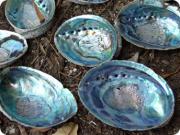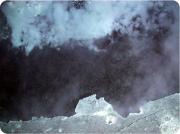Radio Program
Our regular Science and the SeaTM radio program presents marine science topics in an engaging two-minute story format. Our script writers gather ideas for the radio program from the University of Texas Marine Science Institute's researchers and from our very popular college class, Introduction to Oceanography, which we teach to hundreds of non-science majors at The University of Texas at Austin every year. Our radio programs are distributed at to commercial and public radio stations across the country.
Just because something is beautiful doesn’t mean it can’t be tough. Consider mother of pearl -- the irridescent coating on the insides of the shells of some oysters, abalone, and other creatures. Its colorful appearance belies the fact that it’s extremely tough -- about 3,000 times stronger than its individual pieces. Scientists and engineers hope to emulate that toughness in designs for everything from body armor to artificial bones.
If you ever want to drop a boat in the water and let the currents carry you around the world, there’s only one place to go: Antarctica. A wide, deep current circles the entire continent. It’s the only current that will carry you all the way around the globe.
The Antarctic Circumpolar Current was discovered more than three centuries ago by Edmond Halley, for whom Halley’s Comet is named. But scientists didn’t begin to study the current until the last half of the 20th century.
In aquariums and water shows, the Orca looks cute and cuddly. Its streamlined shape, black-and-white coloring, and strong leaps make it a popular performer. But in the wild, it earns its nickname: killer whale. It hunts in packs, and eats just about anything that swims or floats. And it doesn’t matter how big the prey is -- Orcas will attack whales that are many times their own size.
A volcanic mountain is building off the coast of Oregon. It sits atop a “hotspot” -- a bubble of hot rock far beneath the ocean floor. The lava pushes through the plate of rock that forms the Pacific basin, and piles up to form a mountain.
It’s a process that’s played out many times over the last 40 million years or so. It’s built up an entire chain of submerged mountains, known as seamounts. They stretch hundreds of miles to the northwest, far into the Gulf of Alaska. Some of them rise up to two miles high, and come to within a few hundred feet of the surface.
From its name to its feeding habits, the hagfish is one of the least appealing creatures in the sea.
Its long, thin body looks like a fat worm -- and early researchers even classified it as a worm. It burrows into the ooze at the bottom of the ocean, usually waiting for a dead or dying animal to fall from above. And when one does, it burrows into the creature and eats it from the inside out.
A summertime ritual for many teenagers is gassing up the lawnmower and going door to door in search of lawn-mowing jobs. But cutting the grass can be a problem for people who live along bays and estuaries. It can damage beds of seagrass, which provide food and shelter for fish, shellfish, and birds.
An example is in the Barnegat Bay-Little Egg Harbor Estuary in New Jersey. It’s a narrow, shallow body that runs about 40 miles along the coastline.
The bottom of the sea is often described as “otherworldly.” It’s so different from what we see on land -- and so difficult to reach -- that it might as well be the surface of another planet.
But a pool of lava on the side of an undersea volcano takes the “otherworldly” business to a new level. It’s more like the volcanoes on one of the moons of Jupiter than those on Earth.
The male fiddler crab may be a show-off, but he’s also a gentlemen. He gives his burrow to his mate, and he never picks on a female.
Fiddlers are only an inch or two long. But they pack in close together, with thousands of them sharing the same territory in a mangrove forest or on a sandbar or mudflat. Each crab builds a burrow to protect itself against predators, and to provide a den for mating and incubating its eggs.
Most of us think of the ocean depths as dark and silent -- like a giant sensory deprivation tank. But while they’re certainly dark enough, they’re not silent. Sound has no trouble traveling through the oceans. In fact, it travels much faster than it does in the air -- and a lot farther.
Because water is denser than air, sound waves ripple through the oceans almost five times faster than through the air -- almost a mile per second.
But the speed can vary by a couple of hundred miles an hour. It travels faster through warmer water and through greater pressure.
Abalone is popular all around the Pacific Rim, from Santiago to Tokyo. It’s expensive, though, because abalone populations have plummeted in the last few decades, mainly because of overfishing.
The abalone is a type of sea snail. It has a tough spiral shell that’s shaped a little like an ear. It moves around on a large muscle known as a “foot” that sticks out of the bottom of the shell. Tentacles around the foot poke around for food or signs of predators. A full-grown abalone is a few inches across, and some can live for several decades.



